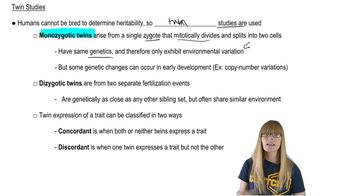Experiments have shown that any nuclei placed in the polar cytoplasm at the posterior pole of the Drosophila egg will differentiate into germ cells. If polar cytoplasm is transplanted into the anterior end of the egg just after fertilization, what will happen to nuclei that migrate into this cytoplasm at the anterior pole?
Table of contents
- 1. Introduction to Genetics51m
- 2. Mendel's Laws of Inheritance3h 37m
- 3. Extensions to Mendelian Inheritance2h 41m
- 4. Genetic Mapping and Linkage2h 28m
- 5. Genetics of Bacteria and Viruses1h 21m
- 6. Chromosomal Variation1h 48m
- 7. DNA and Chromosome Structure56m
- 8. DNA Replication1h 10m
- 9. Mitosis and Meiosis1h 34m
- 10. Transcription1h 0m
- 11. Translation58m
- 12. Gene Regulation in Prokaryotes1h 19m
- 13. Gene Regulation in Eukaryotes44m
- 14. Genetic Control of Development44m
- 15. Genomes and Genomics1h 50m
- 16. Transposable Elements47m
- 17. Mutation, Repair, and Recombination1h 6m
- 18. Molecular Genetic Tools19m
- 19. Cancer Genetics29m
- 20. Quantitative Genetics1h 26m
- 21. Population Genetics50m
- 22. Evolutionary Genetics29m
14. Genetic Control of Development
Early Developmental Steps
Problem 12b
Textbook Question
In mammals, identical twins arise when an embryo derived from a single fertilized egg splits into two independent embryos, producing two genetically identical individuals.
The converse phenotype, fusion of two genetically distinct embryos into a single individual, is also known. What are the genetic implications of such an event?
 Verified step by step guidance
Verified step by step guidance1
Understand the concept of identical twins: Identical twins arise from a single fertilized egg (zygote) that splits into two embryos. These embryos are genetically identical because they originate from the same zygote, which contains the same set of chromosomes from the sperm and egg.
Define the converse phenomenon: The fusion of two genetically distinct embryos into a single individual is known as chimerism. This occurs when two separate zygotes (each with its own unique genetic material) merge during early development to form one organism.
Analyze the genetic implications: A chimera will have cells with two distinct sets of DNA. Some cells will carry the genetic material from one zygote, while others will carry the genetic material from the second zygote. This results in a mosaic of two different genotypes within the same individual.
Consider phenotypic effects: Depending on the distribution of the two cell lineages, the individual may exhibit physical or physiological traits from both genetic lineages. For example, differences in skin pigmentation or blood type may arise if the two zygotes had distinct traits.
Explore potential complications: Chimerism can complicate genetic testing, organ transplantation, and parentage testing, as the individual may have different genetic profiles in different tissues. This phenomenon highlights the complexity of genetic identity in such cases.
 Verified video answer for a similar problem:
Verified video answer for a similar problem:This video solution was recommended by our tutors as helpful for the problem above
Video duration:
1mPlay a video:
Was this helpful?
Key Concepts
Here are the essential concepts you must grasp in order to answer the question correctly.
Identical Twins Formation
Identical twins, or monozygotic twins, form when a single fertilized egg (zygote) undergoes cleavage and splits into two separate embryos. This process results in two individuals who share the same genetic material, leading to identical genotypes and phenotypes. Understanding this mechanism is crucial for exploring genetic similarities and the role of environment in development.
Recommended video:
Guided course

Twin Studies
Genetic Distinctness in Fusion
The fusion of two genetically distinct embryos, known as chimerism, occurs when two separate zygotes merge into one individual. This can lead to a unique genetic makeup, where the individual possesses cells from both embryos, resulting in potential variations in traits and health. This phenomenon raises questions about genetic identity and the implications for inheritance and disease susceptibility.
Recommended video:
Guided course

Descriptive Genetics
Genetic Implications of Chimerism
Chimerism can have significant genetic implications, including the presence of different alleles in various tissues, which may affect phenotypic expression and immune responses. It challenges traditional notions of genetic inheritance and individuality, as chimeric individuals may exhibit traits from both genetic backgrounds. Understanding these implications is essential for fields like genetics, medicine, and evolutionary biology.
Recommended video:
Guided course

Descriptive Genetics

 3:46m
3:46mWatch next
Master Drosophilia Development with a bite sized video explanation from Kylia
Start learningRelated Videos
Related Practice
Textbook Question
435
views
